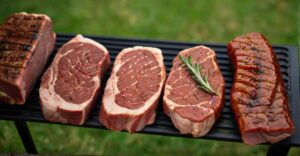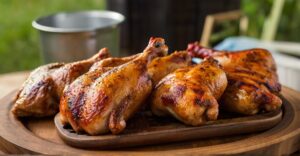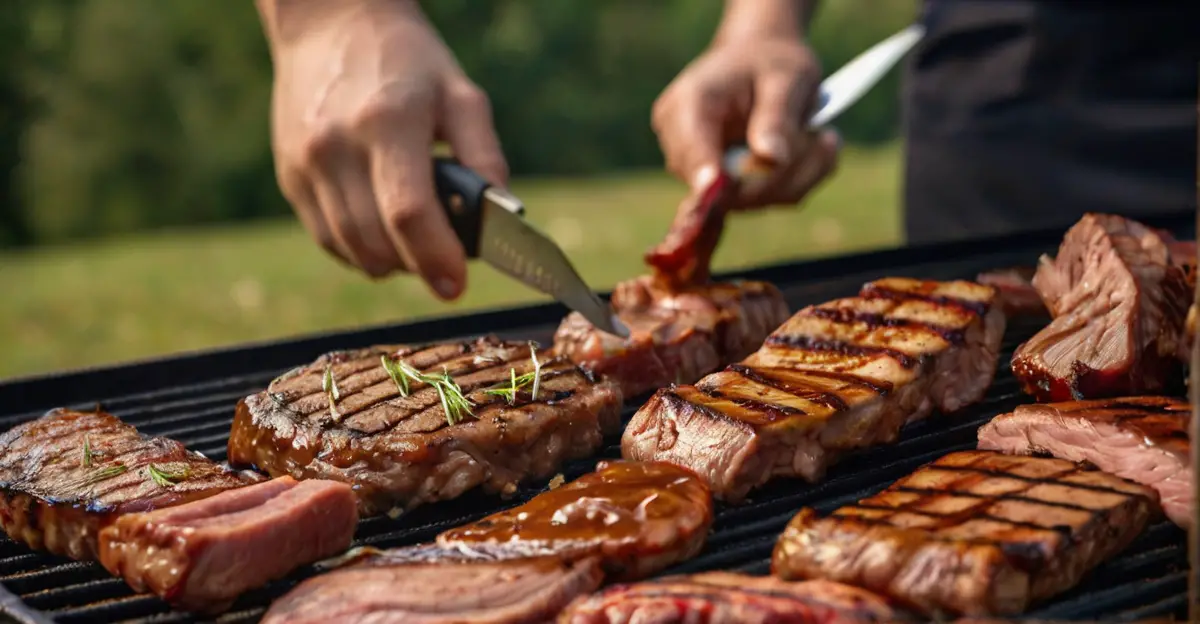As summer beckons, the allure of cooking outdoors with friends and family becomes irresistible. Planning a BBQ or cookout transcends just lighting up the grill; it involves a meticulous agenda to ensure everyone leaves satisfied without the hassle of excessive leftovers. The challenge? Figuring out the right amount of meat per person. Drawing from years of experience and countless cookouts under the warm temperatures of North Carolina, where BBQ is not just a meal but a noun synonymous with pulled pork, I’ve found the guidelines that work.
A good rule of thumb is starting with ½ pound of raw meat per person. This estimation can adjust based on whether the meat is cooked or raw, and the specific type of meat being served. However, it’s not just about the meat. The sides you choose play a crucial role. Starchier sides like potato salad and macaroni and cheese are more filling, potentially reducing the quantity of meat needed, whereas watermelon and potato chips might leave room for more.
Crafting an effortless party where the grill is the centerpiece requires balancing these factors. Questions like “Is meat the main attraction?” or “What type of sides will there be?” are pivotal. For those eating outdoors across the country, considering these aspects ensures a memorable gathering. Whether it’s lighter or heavier sides, the aim is to match the food quantity with the guests’ appetite, ensuring no one goes home hungry or overly stuffed. This approach has consistently provided the answers to my BBQ planning questions, making every event a joyous occasion.
Things to consider
- Meat should be considered the main attraction of your BBQ, but the quantity needed greatly depends on the types of sides you plan to serve. Heavier sides will necessitate smaller portions of meat, whereas lighter sides will mean larger portion sizes are appropriate.
- Consider the demographics of your guests: big eaters like football players might need more, compared to children. Also, the type of meat plays a significant role; chicken drumsticks with bones will have different yields than meat served on a bun, such as burgers or sliders.
- Before heading to the grocery store with your shopping list, calculate the total pounds of meat needed based on your estimate of guests’ appetite and the main course and side dishes you plan to serve. Remember, a pound of raw meat does not equate to a pound of cooked meat due to varying yields.
Type of meat to serve
When deciding on the types of meat to serve at your BBQ, understanding the yield after cooking is crucial. Fat content and whether there’s a bone in the cut of meat significantly affect how much you’ll need. A pound of raw meat typically doesn’t equal a pound once cooked. For average adults, planning around an 8 ounce portion is standard, which is roughly ½ a pound. However, when children are among your guests, adjusting to a ¼ pound serving size is a considerate approach.
Incorporating side dishes into your menu allows for flexibility with meat quantities. A safe way to plan is by allocating ⅓ pound of cooked meat per person if the sides are substantial. For lighter or more limited selections, aiming for ½ pound per individual ensures satisfaction. The choice between heavier and lighter sides can influence the overall amount of meat required.
Strategizing the meat selection also involves considering how it will be served. Will the meat be the star on its own, or complemented with buns as burgers or sliders? This decision impacts portion sizes and the guests’ experience, making the BBQ memorable for its quality and generosity. Balancing these elements effectively ensures that each person enjoys a fulfilling meal, regardless of their appetite or preferences.
How much Beef per person
Ground Beef for Burgers
When it comes to ground beef for burgers, understanding the yield is key to ensuring you have enough for your guests. Typically, a pound of ground beef will result in about ¾ pound of cooked burgers. This reduction in weight accounts for the loss of fat during the cooking process. For portion size, consider that each burger might weigh less than 8 ounces after cooking. If burgers are the main course and you’re pairing them with buns, planning for two per person is a good rule of thumb, especially if you’re serving lighter side dishes like watermelon. However, if you’re offering heavier sides such as roasted potato salad and corn on the cob, one burger per person might suffice.
Hot Dogs for the Cookout
Hot dogs, especially footlong hot dogs, are another popular choice for BBQs. For these, planning for two per person should cover your bases. However, if opting for smaller, standard-size hot dogs, consider increasing this to three per person depending on the side dishes you plan to serve. Spiral hot dogs add a fun twist to the cookout and can make the meal more memorable.
Planning Beef Brisket
When preparing beef brisket, a significant reduction in weight occurs during cooking. A 10 pound raw brisket typically yields about 5 pounds of cooked meat, equating to roughly 10 servings. This is crucial to remember when you see a large brisket at the grocery store and worry about whether it’s too much. In reality, half of that weight is lost, making brisket a dish that requires careful planning to ensure enough is available for all your guests.
Serving Steak at Your BBQ
Steak requires a different planning approach. The average adult will enjoy about an 8 ounce portion of raw steak, but this can vary. For big eaters, you might want to provide larger cuts, whereas smaller cuts can be offered to those with a lighter appetite. Since steaks, particularly boneless steaks, have about a 70% yield after cooking, it’s easier to estimate the amount of meat you’ll need. Remember, fatty meats will lose more during the cooking process, so adjust your estimates based on the type of steak and its weight.
General BBQ Meat Planning Tips
Overall, the key to a successful BBQ is careful planning and understanding the yield of different types of meat. Whether you’re serving ground beef, hot dogs, brisket, or steak, accounting for the cooking process and the appetites of your guests will ensure everyone leaves satisfied. Always adjust your meat purchases based on the side dishes you plan to serve, as they can influence the overall portion size needed per person. With these guidelines, your next BBQ is sure to be a hit.
How much Pork per person
Pulled Pork Planning
For pulled pork, a favorite at any BBQ or cookout, starting with either a pork butt or pork shoulder is common. These cuts typically contain a bone and weigh between 5 and 10 lbs. With a yield of about 50%, a 10 pound raw pork butt translates into approximately 5 pounds of delicious pulled pork. This calculation is vital for ensuring you have enough to serve your guests, making pulled pork a sumptuous centerpiece of your meal.
Pork Ribs Rationing
When it comes to pork ribs, particularly baby back ribs, the rule of thumb is to allot about 6 ribs per person. A single rack consists of about 12 ribs, making it a perfect share for two. If you’re leaning towards cooking beef ribs, remember they’re larger, so estimating around 2-3 ribs per person should suffice. This guideline helps in planning the right amount for your guests, ensuring everyone gets a taste of these succulent delights.
Comprehensive Pork Serving Guide
Pulled pork and ribs are just two examples of how versatile pork can be for your gatherings. When planning how much pork to serve per person, considering the yield after cooking and the size of your party is crucial. Whether it’s the tender pulled pork from a pork butt or the hearty rack of baby back ribs, calculating the right amount ensures a successful BBQ. Remember, the joy of a cookout is in sharing great food with friends and family, and a little planning goes a long way in creating memorable meals.
Tailoring to Your Crowd
Adjusting your quantities based on the type of guests—whether they prefer leaner cuts like the shoulder or fattier options like the butt—and their appetite sizes will make your event a hit. A deeper understanding of the average weights and yield percentages helps in crafting a menu that’s both satisfying and efficient, minimizing waste while maximizing enjoyment.
Execution and Enjoyment
Ultimately, the art of BBQ planning is in the balance—balancing weights, yields, and guests’ preferences to craft an event that’s remembered for its abundance and flavor. Whether it’s pulled pork for a large crowd or ribs that require more individual consideration, the key to a successful cookout lies in thoughtful preparation and an understanding of how much to serve. This guide aims to take the guesswork out of your planning, ensuring that your BBQ is as delicious and enjoyable as possible, with every guest leaving satisfied.
How Much Chicken Per Person
When it comes to chicken at cookouts, its versatility shines through, offering a variety of options from chicken breasts to drumsticks and wings. For boneless chicken breasts, the standard is one per person, weighing around 6 ounces. However, when serving chicken pieces like boneless thighs and drumsticks, you’ll want to plan for 2 pieces per person. But if you’re focusing solely on drumsticks, bumping that number up to 3 per person ensures there’s plenty to go around.
Serving Wings and Accompanying Sides
Chicken wings require a different approach, especially considering they’re a favorite that everyone loves. If they’re part of a larger menu with various sides, then 6 wings per person should suffice. Yet, for those gatherings where wings are the star attraction, doubling that amount to 12 per person guarantees satisfaction without the worry of running short. This adjustment acknowledges the wings’ smaller size and the enthusiasm guests have for them.
Ensuring a Memorable Cookout
In crafting the perfect BBQ menu, understanding the nuances of how much chicken to serve per guest—taking into account the type of cut and the presence of other sides—is key to a successful event. Whether it’s the lean elegance of a chicken breast or the communal joy of sharing a platter of wings, ensuring each person gets their fill while experiencing the variety on offer makes for an unforgettable cookout. This guide, drawn from personal experience and expertise, aims to help you navigate these decisions with confidence, ensuring your BBQ is remembered for its abundance and flavor.
Best Bread for a BBQ
Choosing the right bread for a BBQ can elevate the entire dining experience, blending flavors and textures in a way that complements the main dishes. Hawaiian rolls are a top pick for many, thanks to their slightly sweet flavor derived from pineapple juice. These rolls are not only delicious on their own but also perfect for sliders, making them a versatile choice for any cookout. Their ability to be made ahead of time, frozen, and then warmed in a slow cooker ensures they’re always fresh, keeping you out of the kitchen and in the midst of the action.
Cornbread and biscuits offer a more traditional side that pairs exceptionally well with BBQ meats. The hearty texture of cornbread or a cornbread biscuit provides a satisfying contrast to both the tenderness of the meat and the crispness of fresh salads. For those looking to impress, homemade biscuits or cornbread made from scratch can add a personal touch that guests will appreciate.
Incorporating these bread options into your BBQ menu not only caters to a range of tastes but also adds layers of flavor and texture to the meal. Whether it’s the convenience and sweetness of Hawaiian rolls, the rustic charm of cornbread, or the buttery richness of biscuits, selecting the right bread can significantly enhance the overall barbecue experience. Each option has its unique way of complementing the smoky flavors of BBQ, ensuring there’s something for everyone to enjoy at your next outdoor gathering.
Concluion
In wrapping up our guide on the “How Much Meat Per Person for BBQ” and the “Best Bread for a BBQ,” it’s clear that successful BBQ planning hinges on understanding the intricacies of meat portions and the complementary roles of bread options. Whether it’s calculating the right amount of pork, beef, or chicken to satisfy your guests or choosing between Hawaiian rolls, cornbread, and biscuits to elevate the meal, each decision plays a pivotal role in crafting a memorable outdoor dining experience. Armed with these insights and tips, you’re well-equipped to host a BBQ that not only delights the taste buds but also brings people together in celebration of good food and great company.
FAQs
Q1. Is 1 pound of meat enough for 4 people?
Typically, 1 pound of meat is not enough for 4 adults. The standard serving size is ½ pound per person, meaning you’d need at least 2 pounds for 4 people.
Q2. How much meat do you need for 8 people?
For 8 people, you should plan for about 4 pounds of meat. This estimate assumes a serving size of ½ pound per person.
Q3. What weight of meat per person to order?
It’s recommended to order approximately ½ pound (or about 225 grams) of meat per person. This can vary depending on the type of meal and the appetites of your guests.
Q4. How much meat is a kg per person?
One kilogram (kg) of meat per person is significantly more than the standard serving size. A kg is about 2.2 pounds, so for most meals, ¼ to ½ kg (250-500 grams) per person is sufficient.
Q5. How many pounds of meat can one person eat?
While this can vary greatly depending on the individual’s appetite, a general guideline for a meal is about ½ pound per person. Competitive eaters or those with larger appetites may consume more.

